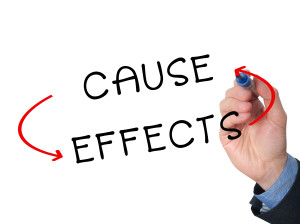Help Blog Readers Know the Difference Between Related and Causal
 In statistics, variables are considered related if, when the value of one increases or decreases, so does the value of the other (even if it’s in the opposite direction). But does that mean one caused the other? Not necessarily. Only after investigating whether one action causes the other, explains the Australian Bureau of Statistics, can we “put in place policies and programs that aim to bring about a desired outcome.”
In statistics, variables are considered related if, when the value of one increases or decreases, so does the value of the other (even if it’s in the opposite direction). But does that mean one caused the other? Not necessarily. Only after investigating whether one action causes the other, explains the Australian Bureau of Statistics, can we “put in place policies and programs that aim to bring about a desired outcome.”
The article gives three examples of questions about whether the difference between two things is simply incidental versus one causing the other:
- Is there a relationship between a person’s education level and their health?
- Is pet ownership associated with living longer?
- Did a company’s marketing campaign increase their product sales?
In writing blog content, citing causal statistics certainly is one method used to capture readers’ attention. “Insomnia costs U.S. $63 billion annually in lost productivity“ is a great opener for a furniture store blog about mattresses, for example. And if the content also contains a human interest story about how Jimmy’s lack of sleep caused him to flub an all-important job interview, that combination packs a real punch with blog readers.
Statistics can actually serve as mythbusters. If there’s some false impression people seem to have about your industry or about a product or service you provide, you can bring in statistics to show readers that the numbers they’ve been hearing about may be related, but that one factor is not the cause of the other. From there, you can offer more relevant solutions to their issues.
In everyday life, people routinely make causal claims that would require a counterfactual analysis to confirm, says explorable.com. “Thanks to a new diet, your neighbor lost thirty pounds. But did your neighbor not also take up jogging? To assess the claim that A caused B we need to consider a counterfactual: What would have happened if A had been different? To evaluate whether your neighbor’s dieting caused his weight loss, we need to consider what would have happened had he not dieted, and so on.”
In the natural course of doing business, misunderstandings about a product or service often surface in the form of customer questions and comments. Addressing misinformation in a company’s blog shines light on the owner’s special expertise, besides offering information that is valuable to readers. De-mystifying matters can make your blog into a “go-to” source for readers seeking information in your field.
How can you use myths and “counterfacts” to enhance your credibility as a business owner?

Leave a Reply
Want to join the discussion?Feel free to contribute!